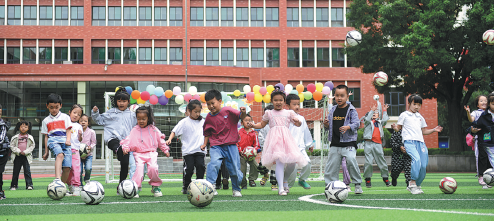Long-term investments in Shanxi's well-being
Updated: 2022-09-23

Dozens of students from a primary school in Taiyuan have fun by kicking footballs on campus. [Photo by Shi Xiaobo for China Daily]
Universal healthcare, compulsory education and financial assistance for vulnerable people all contributing to improve locals' life satisfaction
Over the past 10 years, the North China province of Shanxi has increased its investment in initiatives that improve livelihoods, aiming to strengthen people's sense of gain, happiness and security.
One sector that Shanxi has devoted much energy to is healthcare, according to an official in the Shanxi provincial government.
The official said now that it has established a medical care insurance system to help residents access free and universal services, the province is shifting emphasis to allocating better resources to the sector and helping to improve the levels of service for medical institutions and medical workers.
Shanxi's medical care insurance system, which is sponsored by the governments at various levels, now covers more than 32 million residents, or 95 percent of its population.
The official said that the use of digital technologies makes it possible for Shanxi's medical institutions to use advantageous resources throughout the country.
On July 27, for instance, medics at the cardiovascular center of the Hospital Affiliated to Shanxi University of Chinese Medicine, based in the provincial capital of Taiyuan, attended an online conference. There, experts from Beijing's Xiyuan Hospital gave suggestions on treating difficult and complicated cases.
The hospital in Taiyuan has cooperated with Xiyuan Hospital for several years, especially in the fields of cardiovascular, brain and blood diseases, tumors and rheumatology.
In addition to holding remote diagnosis meetings regularly, Xiyuan Hospital has dispatched experts to the Taiyuan hospital to share their expertise with doctors.
While introducing resources from across the country, Shanxi's leading hospitals, mostly in Taiyuan, have branched out throughout the province. They have helped medical institutions in smaller cities and rural areas improve their services.
For instance, the Shanxi Bethune Hospital, the Shanxi Provincial Cancer Hospital and the Hospital Affiliated to the SUCM have built branches in the cities of Datong, Changzhi, Linfen and Yuncheng to share resources.
In Shanxi, a 5G-enabled remote diagnosis system plays an increasingly important role in boosting medical services across county-level regions.
Backed by emerging technologies, leading local hospitals and medical companies, some counties and districts in Shanxi — including the counties of Jiexiu, Zezhou, Xiaoyi and Yicheng, as well as Xinghualing district in Taiyuan — have grown into national or provincial demonstration areas for the comprehensive development of healthcare industries.
In Shanxi as a whole, internet technologies have helped to build a unified medical insurance system, with the development of a provincial network for the sharing of data and information.
Another area of livelihood improvement that Shanxi has highlighted is education.
After developing a compulsory education system from primary to junior middle school students, Shanxi is now extending universal education services to kindergartens.
Local statistics show the province has a total of 2,961 kindergartens enjoying universal educational services. It means that even low-income families can afford high-quality preschool education.
The province has also increased its investment to improve the quality of compulsory education. Over the past 10 years, Shanxi has channeled a total of 12 billion yuan ($1.7 billion) to upgrade educational facilities for primary and junior middle schools. By adding accommodation, a total of 1,550 schools in the rural areas are now able to enroll boarding students.
Shanxi is now promoting a strategy to balance educational development between big and small cities, and between urban and rural areas.
On Aug 3, a new school in the district of Yuci in Jinzhong city began to enroll students. The school was established by Shanxi Normal University, according to an agreement it signed with the Jinzhong city government on April 1.
The SNU, based in Taiyuan, is the top university in the province for training teachers. By founding the school, it means Jinzhong is able to enjoy educational resources from the provincial capital.
The school can offer lessons to about 3,500 students, according to local officials.
Leading educational institutions in Taiyuan and other big cities, mostly middle schools, are also branching out, aiming to share their resources with smaller cities and rural areas across Shanxi.
The province's new endeavor to improve educational quality is to implement the "double reduction" campaign. The initiative eases the burdens of excessive homework and off-campus tutoring for students in compulsory education. Researchers believe the campaign can help with the all-around development of students. They are encouraged to take part in more physical activities that are good for their health and to develop personal interests.
In addition to healthcare and education, Shanxi's efforts to improve people's livelihoods include a pension system for the elderly and an assistance system for the underprivileged, such as the unemployed and disabled.
Local statistics show that the province's basic pension system covered more than 26 million people by the end of 2021. During 2012-22, Shanxi invested a total of 53.87 billion yuan in offering assistance to underprivileged residents.
Qin Yang, Li Linxia and Gao Jianhua contributed to this story.



